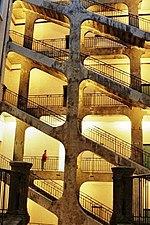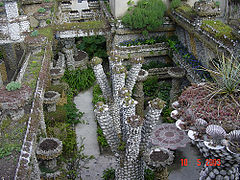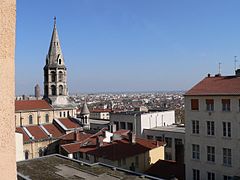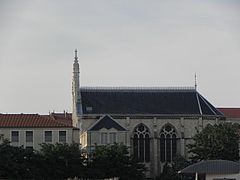La Croix-Rousse
| La Croix-Rousse | ||
|---|---|---|
|
|
||
| local community | Lyon | |
| region | Auvergne-Rhône-Alpes | |
| Department | Rhône | |
| Arrondissement |
1st arrondissement (Lyon) 4th arrondissement (Lyon) |
|
| Coordinates | 45 ° 47 ′ N , 4 ° 50 ′ E | |
| Post Code | 69001 69004 |
|
| Former INSEE code | 69381/4 | |
 The hill of La Croix-Rousse, taken from the Fourvière |
||
La Croix-Rousse is a hill in Lyon and at the same time a district that consists of two geographical parts: the slopes (part of the 1st arrondissement ) and the plateau up to 254 m in the 4th arrondissement .
La Croix-Rousse (nicknamed The Hill That Works ), a formerly independent municipality in the Rhône department , is shaped by its past as a stronghold of the silk industry .
history
De condate on the Saint-Sébastien mountain
A Latin tablet found in the Rue de la Vieille names the place “pagus de Condate” (“Quarter of the Confluence”). As the archaeologist Amable Audin found out, Condate was a Gallic place name from Roman times , when a Celtic settlement was at the foot of the hill and the city of Lugdunum (place of the god Lugus ) developed on the other side of the Saône . Although this theory is often advocated in works on the ancient history of Lyon, no archaeological evidence of a Celtic settlement prior to the founding of Lugdunum has yet been found. The oldest proven traces of settlement come from Roman times and date from the year 10 BC. BC, the period of the founding of the Ara trium Galliarum .
Earlier isolated excavations, but also more recent excavations (1985) on the slope Grande Côte , testify to a late settlement development that developed especially at the foot and slope of the hill during the Roman Empire and continued into the 4th century, as many finds prove : Mosaics, traces of residential buildings or workshops (potters, glaziers), tillage, Roman monuments, inscriptions. Among the inscriptions, the table claudienne deserves special mention, two fragments of which were discovered in 1528 in a vineyard halfway up the hill.
Renovation measures in 1854 unearthed traces of a granite- paved Roman road on the Montée des Carmelites and Place Ferdinand-Rey , which was identified as the “road to the Rhine”. The discovery of further road remains in various places testify to a dense local road network.
The most important monument in La Croix-Rousse is the Ara trium Galliarum , a sanctuary for Roma and Augustus, where the representatives of the 60 Gallic tribes gathered every year. The Lyon amphitheater also belonged to the same complex .
On the basis of many archaeological evaluations, Amable Audin suggested setting up the altar for Rome and Augustus in the Rue des Tables Claudiennes, imagining a large esplanade of 296 × 69 m similar to the sanctuary of Fortuna Primagenia in Praeneste . This location was controversial because one could have built apartments on the terrace complex; the discovery of mosaics in the designated place on rue Pouteau made Audin's proposal obsolete.
After the great migration , the Gallo-Roman settlement was abandoned.
In the Middle Ages , the Lyon district ended at Place des Terreaux . "Montagne Saint-Sébastien" was part of Franc-Lyonnais (in the Principality of Savoy ), an independent province under the special protection of the French kings. The slopes and the plateau were used for agriculture, especially for vineyards.
etymology
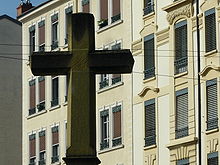
from Croix-Rousse,
In 1512, Louis XII decided . to build a fortress on the hill to defend Lyon. This fortification, called Saint-Sébastien, integrated the slopes in Lyon, but isolated the plateau and thus created a new suburb.
At the same time, a cross was erected on the plateau , carved in Pierres dorées , an ocher limestone from Couzon-au-Mont-d'Or . The cross gave the newly created village its name. It is believed that this cross stood at the crossroads of two streets: one leads to Dombes (towards Bourg), the other to Neuville . The cross was destroyed and restored several times (torn down by the Protestants in 1562, destroyed during the Revolution, removed in 1881 by decision of the Lyon City Council). Finally, in 1994, a replica was built on Place Joannès-Ambre .
From the hill that prays ...
As a result of its integration in Lyon, the slope, which had previously only been used for agriculture, was settled after the fortifications were built. In the 16th and 17th centuries, many religious institutions settled here, starting in 1580 with Carthusians , followed by Carmelites , then Annunciants , etc.
In contrast to the slope, the plateau always remained part of Cuire and thus part of the Franc-Lyonnais . At the end of the 18th century, the place on the plateau of Croix-Rousse, which was a small settlement for a long time, gained in importance: religious orders settled here too, and numerous merchants joined them, mainly because the Taxes were lower than in Lyon.
... to the hill that works
During the revolution , goods belonging to religious communities were sold, freeing a large number of properties. The rivalry between the farmers of Cuire and the citizens of Croix-Rousse gave birth to the municipality of Cuire-la-Croix-Rousse . Finally, on May 5, 1797, the Council of Five Hundred decreed that Cuire be bound to Caluire, thus ending the split; but one had to wait until the decree of the French consulate of October 22, 1802, before the municipality of La Croix-Rousse could arise.
At the beginning of the 19th century, Lyon was the most important working-class city in France. The arrival of numerous silk weavers completely changed La Croix-Rousse and shaped its history and settlement. La Croix-Rousse became a stronghold of industrial silk weaving . The construction of housing for the workers' families and weaving mills flourished. These were five or six-story buildings that housed both the apartments and the workshops. Because of the looms used, the workshops had very high ceilings, often 4 m high, and high windows, because good light made it easier to work with the silk, with a mezzanine floor for the family. The ceilings were often reinforced with oak beams to allow the machines to be attached.
Under the influence of the urban developers who opened up the formerly religious area, the east elevation of the hill changed radically. The number of residents exploded and new streets were sometimes built in a chaotic manner without the city administration being able to say anything about it.
Jules Michelet wrote about the opposing mountains ( mountain of work and mountain of mysticism ), because now the monasteries and churches gathered on the hill of Fourvière . Over the years Jule Michelet's saying has been transformed into The Hill That Works and The Hill That Prays .
The Canuts (German: Seidenweber von Lyon) revolted several times against their difficult working conditions. The uprising of the silk weavers in Lyon in November 1831 is considered one of the first workers' revolts . Under the shouts of "Vivre libre en travaillant ou mourir en combattant!" (for example: work freely or die fighting ) they occupied Lyon. Louis-Philippe I sent 20,000 soldiers and 150 cannons to quell the turmoil that was spreading from the La Croix-Rousse district and which upset the entire industrial milieu as far as Paris. The city became an important industrial city in the 19th century, thanks in large part to the Canuts .
On February 14, 1834, the Canuts revolted again and occupied the fortress of La Croix-Rousse. They were able to hold her against 12,000 soldiers for six days.
A third uprising took place in 1848 on the occasion of the proclamation of the Second French Republic under the leadership of the Voraces .
In 1849, the Voraces led a 4th uprising to support the Paris Republicans. It mostly took place in the suburb of La Croix-Rousse and was violently suppressed.
Connection to Lyon
In 1818 la Croix-Rousse was raised to the rank of town. But it was divided when, on October 28, 1832, a royal orderly established the Serin and Saint-Clair districts as independent parishes. However, this was short-lived, because in 1834 the two were reintegrated into the municipality of La Croix-Rousse.
In 1852, La Croix-Rousse, which had meanwhile grown to 30,000 inhabitants, was annexed to Lyon (imperial decree of March 24, 1862). At that time, Prefect Claude-Marius Vaïsse initiated a series of construction measures (supply of drinking water; construction of the Hôpital de la Croix-Rousse , etc.). In 1862 the Funiculaire de la rue Terme went into operation and connected the center of Lyon with La Croix-Rousse. In Lyon, it soon became known as the ficelle . The following year, Compagnie du chemin de fer de Lyon (la Croix-Rousse) in camp de Sathonay opened the Lyon-Croix-Rousse station next to the funicular station. This station is the starting point for the line from Lyon to Sathonay - Rillieux station and, from June 1, 1882, on to Trévoux . In order to facilitate the incorporation of La Croix-Rousse into the city, the walls were destroyed, creating the Boulevard de l'Empereur . The mayor's office was built here and trees were planted.
Since 1952, the Croix-Rousse tunnels have been running under the hill , connecting the quays of the Rhône with those of the Saône ( RN 6 ).
In 1980 the textile industry fell into a severe crisis. The few companies that survived this were able to reorient themselves towards the production of "technical" textiles or very high-quality textiles (e.g. Prelle, Tassinari, Brochier, Bianchini-Férier).
Even today, La Croix-Rousse is still a well-populated district, highlighted by its geography (hills), its history ( history of the silk industry in Lyon ), its ongoing social movement and its high population density , one of the strongest in Europe.
Social laboratory
La Croix-rousse has a special reputation: In the working-class quarters of the 19th century, there was the first social unrest of the industrial age (see: uprising of the silk weavers in Lyon ). Numerous social innovations also emerged here: first French labor court , first experiences with mutual insurance, first consumer cooperatives in France and others (see also the uprising of the silk weavers in Lyon).
In the 20th century the quarter (especially on the slopes) remained a real “social laboratory”: squatting , self-managed restaurants, parents' school, secret printing works, militias, associations for various purposes, etc.
At the beginning of the 21st century, despite the change in population under the pressure of rising rents, the district remains a place of particular liveliness that still generates interesting initiatives (for example, Fair Trade on the Pentes , the public crier .)
geography
La Croix-Rousse lies between the two rivers Rhône and Saône in the northern extension of the Presqu'île and thus on one of the two hills that define Lyon (the other is the 300 m high Fourvière ). It is 250 m high and is therefore a few hundred meters above the city.
Some pentes , called "Balmes" and created by water erosion, are real steep walls from 20 to 40 m high. The last spectacular demolitions occurred here in 1935 and 1977.
The hill of La Croix-Rousse is actually the south side of a plateau that continues north with the municipalities of Caluire-et-Cuire , Sathonay-Camp , Rillieux-la-Pape et Fontaines-sur-Saône .
La Croix-Rousse, two different parts of the city
The slopes of La Croix-Rousse

The quarters on the slope (fr: Pentes de La Croix-Rousse) are in the 1st arrondissement and rise from Place des Terreaux to the summit.
The streets in this neighborhood are steep. Therefore some have the name "ascent" (fr: montée; Montée de la Grande-Côte , Montée Saint-Sébastien, Montée des Carmélites , Montée Neyret ...)
The Montée de la Grande-Côte is one of the steepest, because it crosses the district on a direct ascent. The Montée des Carmelites follows the (Roman) road to the Rhine; it ran from Lugdunum to Germania. At the beginning of the ascent of the Carmelites is the botanical garden (fr: Jardin des Plantes), from where you have a beautiful view of the peninsula and the Fouvière. Here is also the amphitheater of Lyon , formerly an important administrative center of the Gauls ( Ara trium Galliarum ).
In addition to the Montées and other thoroughfares, there are numerous through-houses here , but they differ from those of Vieux Lyon . These passages between the houses are partly covered and lead via stairs. They thus form a direct route to the mountain.
The pentes are therefore more of a neighborhood for pedestrians than for cars (narrow, steep streets, stairs, one-way streets, no parking). The district is also very different from the rest of Lyon because of its Canuts culture . The strong trade union and cooperative thinking, which in turn comes from the textile industry, is derived from it.
Today, the Pentes is shaped by an informal and associative culture that particularly attracts students and artists. It is a village full of alternative ways of life.
The cityscape has been greatly enhanced by a large-scale renovation and urban armament in the 1990s; with this the quarter loses its working-class character and becomes an attraction for the nouveau riche .
The Croix-Rousse plateau
The Croix-Rousse plateau ( 4th arrondissement ) is a plateau between the Rhône and the Saône, roughly the area from the Boulevard de la Croix-Rousse to the borders of Caluire-et-Cuire (theater and hospital of La Croix- Rousse). The area is a purely residential area and differs from the rest of Lyon in its “village” character. This impression is reinforced by the boules courts (like the one at Clos Jouve ) or the weekly “petits marchés” on the Place de La Croix-Rousse, surrounded by “ bistros ”. Indeed, the inhabitants cultivate a certain distance from the rest of Lyon. The pentes form a natural border that makes the plateau appear as a special part. When the residents go to other arrondissements, they say they are descending into the city .
The plateau is crossed by two commercial streets:
- from north to south, the Grande rue de la Croix-Rousse (through the 4th arrondissement )
- from east to west, the Boulevard de la Croix-Rousse (which is the border between the 1st and 4th arrondissement)
On the east side of the plateau there are mainly silk weaver houses. Here you can also find the typical Traboules , but less numerous than in the Pentes .
Local lore
On December 5, 1998, historic Lyon was added to the UNESCO World Heritage List . This is the area within the former fortress around the hill of Fouvièr , large parts of the peninsula and the Pentes of La Croix-Rousse.
Private and Notable Buildings
Architecture: silk weavers and traboules
| The traboule in La Croix-Rousse |
|---|
|
- Montée de la Grande-Côte with a magnificent panorama at the end of the climb
- Building of the silk weavers (especially the Maison Brunet or the «House of 365 Windows»)
- The Traboules : the Cour des Voraces , the Thiaffait passage ...
"The Big Stone"
A symbol for the district is the Gros Caillou , a boulder, the mineralogical composition of which suggests that it was transported here from the Alps by a glacier (see foundling ). The rock was found in 1862 during excavations for the construction of the ficelle between the peninsula and La Croix-Rousse: The work on the tunnel had to be interrupted because the workers were stopped by a rock that they could not drill through due to its extreme hardness. The obstacle had to be exposed and removed, which caused a lot of effort and of course also meant a delay in the work. When the "Gros Caillou" was then exposed, it became a symbol of the strength and perseverance of the Lyons in the face of difficulties, but also a symbol of the ties between La Croix-Rousse and Lyons, which were expressed through the funiculaire . The Gros Caillou was placed at the east end of the boulevard, where it dominates the Rhone and the plains up to the Alps.
At first the boulder stood at the point where the 1st (les Pentes) and the 4th arrondissement (Lyon) (plateau of La Croix-Rousse) meet. When an underground car park was built and a park (Espace Gros-Caillou) was created above it , it had to be moved about 30 m and is now in the area of the 1st arrondissement, which some older residents do not like.
Gros Caillou achieved immortality in youth literature through the novel series Six Comapagnons de la Crois-Rousse by the youth author Paul-Jacques Bonzon published by Bibliothèque Verte.
According to legend, the rock is also said to represent the heart of a greedy notary who put a disinherited silk weaver family on the street.
The underground
Under the hill of La Croix-Rousse there is one of the oldest galleries in Lyons, but it has been closed to the public since 1989 by a municipal decree.
The oldest underground trenches often date back to the Roman drainage system, which was used to prevent water from entering or to divert it so the hill would not sink. The numerous monasteries later redesigned these Roman pipe systems and made them usable for their facilities. In the 16th and 17th centuries, when the city fortifications were being built around Lyon, underground passages were built for military purposes.
It is believed that the Arêtes de poisson (German: herringbone pattern ) of the "réseau des Fantasques" (German: whimsical network) , which bears this name because it is reminiscent of a fish skeleton, is of military origin. It could have served as material accommodation. But that's just a hypothesis so far. At least one of the bones seems to have served as a catacomb .
Most of the underground passages were forgotten at the latest when the problem of the water supply of La Croix-Rousse was settled in the 19th century.
Defensive wall of La Croix-Rousse
This long defensive wall was part of the first fortifications of Lyon that closed the city to the north. It was rebuilt in 1834 on the old foundations (from the 16th century, which were destroyed after the siege of Lyon in 1793) and was intended to protect Lyon if the fortifications of Caluire and Montessuy did not withstand the enemy.
This belt of fortifications comprised 6 bastions that protruded 10 m above the moat that surrounded them.
Other structures
- Jardin Rosa Mir ;
- la maison Brunet , called the house of 365 windows ;
- Clos Jouve , main place of the Boule Lyonnaise ;
- On the northern edge there are houses that have a "defensive character" (remains of the defensive wall). Only the forts Saint-Jean and Saint-Laurent have survived;
- The Villemanzy manor house with garden (formerly hôpital militaire Villemanzy );
- [[Institution des Chartreux ]], high school in the former Chartreuse du Lys-Saint-Esprit (17th century);
- The private high school Saint Jean-Baptiste de La Salle in the former building of the Adoration perpétuelle du Sacré-Cœur , recognized by the Church as a congregation in 1824. Before the revolution, the building belonged to the monks of the Chartreuse du Lys Saint-Esprit .
- Clinique du Saint-Rédempteur , former leper colony on Rue d' Ypers , in operation since 1946.
La maison Brunet View from the Saône.
Religious Heritage
At the foot of the slope to the Croix-Rousse, which has been inhabited since the Gallo-Roman era, you can admire the Amphithéâtre des Trois Gaules . In the center of the ancient amphitheater there is a post commemorating the torments of Blandina , Pothinus and the martyr of Lyon .
- Église Saint-Bruno des Chartreux , baroque gem, masterpiece by Ferdinand-Sigismond Delamonce , one of the most beautiful canopies in France, made by Servandoni
- Église du Bon Pasteur , a surprising but inaccessible church
- Église Saint-Polycarpe , former church of the oratorios between rue René Leynaud and the two passages Mermet et Thiaffait
- Église Saint-Bernard , Montée Saint-Sébastien, near the plateau (the church was profaned .)
- Chapelle des Chartreux ( Institution des Chartreux )
- La chapelle du Sacré-Cœur des Chartreux (Lycée Saint-Jean-Baptiste de La Salle)
- Église Saint-Augustin : Roman-Byzantine style church (Rue Jacquard)
- Église Saint-Denis: historic parish in the north of La Croix-Rousse ( rue Hénon )
- Église Sainte-Élisabeth: modern church ( rue Hénon )
Inside of the baroque church of Saint-Bruno des Chartreux .
Chapel of the Institution of Chartreux .
Cultural heritage
- Théâtre de la Croix-Rousse
- Villa Gillet (mostly contemporary art)
- Subsistances , “Laboratory for Contemporary Creations” Quai Saint Vincent on the banks of the Saône
- rue Burdeau with numerous contemporary art galleries
- Numerous café theaters
- The Quartier des Capucins with its numerous boutiques
Films shot in La Croix-Rousse
- Lucie Aubrac by Claude Berri (1997)
- Everything's fine ( we're disappearing) by Claude Mouriéras (2000)
- J'ai tué Clémence Acéra by Jean-Luc Gaget (2001)
- Inventaire filmé des rues de la Croix-Rousse by Gérard Courant (2002)
- Les Diables by Christophe Ruggia (2002)
- The day that changed everything by Gaël Morel (2007)
- Rivals by Jacques Maillot (2008)
- The Flying Merchant by Eric Guirado (2007)
References in literature
- Le Banquet , Jules Michelet , 1878
- Les Six Compagnons de la Croix-Rousse , de Paul-Jacques Bonzon (Bibliothèque Verte)
- Félicité de la Croix-Rousse , Charles Exbrayat , 1968
- La Révolte à deux sous , Bernard Clavel
- La Place , Annie Ernaux : "I passé les épreuves pratiques du Capes dans un lycée de Lyon , à la Croix-Rousse" (the first sentence of the book).
- "Demain tu pars en France" with the subtitle "Du ravin béni-safien au gros caillou lyonnais" by Claude DIAZ (L'Harmattan 2011)
References in music
- Le chant des Canuts by Aristide Bruant (1894)
- St Jean Croix Rousse by Zen Zila (2001)
- Montée Bonafous of Kent
- “Bienvenue à la Croix Rousse”, “L'Ancienne” by Bistanclaque
- " Les pentes ", Dj Fly (Champion du monde DMC 2008 and 2013)
Personalities
- Azouz Begag , sociologist, former minister
- Dominique Blanc , comedian
- Clovis Cornillac , actor
- Gérard Courant , filmmaker
- Frédéric Dard , writer
- Virginie Despentes , writer, filmmaker (As a writer, she took the name of her neighborhood.)
- Pierre Dupont , chansonnier
- Camille Jordan , mathematician
- Florence Foresti , comedian and humorist
- Jean Michel Jarre , writer and composer of electronic music
- Kent , singer
- André Latreille , university professor
- André Manoukian , author and composer
- Michel Noir , politician
- Christophe Petchanatz , musician, writer
- L ' Abbé Pierre , dedicated to the homeless
- Sully Prudhomme , writer, Nobel Prize winner
- Sylvie Testud , theater and film actress
- Claudine Thévenet , founder of the Congrégation des Religieuses de Jésus-Marie
- Cédric Villani , mathematician (Fields Medal 2010)
Events and more
- The Grand Marché of La Croix-Rousse, which takes place every day (except Monday) along the boulevard (one kilometer long).
- The Vogue des marrons festival in autumn
- The crier comes on Saturday and Sunday mornings .
- Every year in September, the République des Canuts grapes are picked ( Parc de la Cerisaie )
- On the 2nd weekend in September, the “Grand Braderie” (flea market) takes place in the Grand-Rue and on the Place de la Croix-Rousse.
- Since 2008 there is a monthly La Ficelle , which reports on the events in La Croix-Rousse and Caluire-et-Cuire ; Current edition: 15,000.
- The website ( www.petiteshistoiresxrousse.fr ) run by the District Council of the 4th arrondissement brings back memories of old and new: little stories and events that shape life in La Croix-Rousse and have shaped life in the past.
- A quarter of Oyonnax and the central square there is called «Croix-Rousse». In this way, industrialists from Lyon who worked here have shown their connection to the place, which are similar in geography: This district is also located above the old town and can be reached via steep driveways.
Transport links
The district is connected to the center of Lyon by the Métro Lyon line C and has 3 stations: Croix-Paquet , Croix-Rousse and Hénon .
literature
- A Lyon, La Croix-Rousse demeure un quartier rebelle In: Le Monde 01/08/2003.
- Jean Pelletier: Connaître son arrondissement - le 4e. Éditions lyonnaises d'art et d'histoire, ISBN 2-84147-043-1 .
- Louis F. Lacroux: La Croix-Rousse en flânant. Editions Xavier Lejeune.
- Bernard Collonges: Le quartier des Capucins - Histoire du bas des pentes de la Croix-Rousse. Editions Aléas, September 2004, ISBN 2-84301-100-0 .
- Josette Barre, La colline de la Croix-Rousse , Éditions Lyonnaises d'Art et d'Histoire
- François Dallemagne, (Photography: Georges Fessy): Les défenses de Lyon: enceintes et fortifications. Éditions Lyonnaises d'Art et d'Histoire, Lyon 2006, ISBN 2-84147-177-2 , pp. 92-93.
- Alfred Colling, La Prodigieuse Histoire de la Bourse. 1949.
- Laurence Tranoyd, Grégoire Ayala: Les pentes de la Croix-Rousse à Lyon dans l'Antiquité. État des connaissances. Gallia, Volume 51, 1994, pp. 171-189 ( persee.fr original text).
Web links
- Fromage fort de la Croix-Rousse
- ficelle , the world's first funicular
- La Croix-Rousse cemetery
- Littré de la Grand'Côte (de Nizier du Puitspelu ), the standard work for the Lyon dialect
- Gros Caillou
- Histoire de Lyon
Individual evidence
- ^ Inscription found CIL XIII, 1670
- ↑ Amable Audin : Essai sur la topographie de Lugdunum , Audin, Lyon, 1959, pp. 23–24
- ↑ Laurence Tranoy and Grégoire Ayala: Les pentes de la Croix-Rousse à Lyon dans l'Antiquité. État des connaissances. Pp. 173-174
- ↑ Laurence Tranoy and Grégoire Ayala: Les pentes de la Croix-Rousse à Lyon dans l'Antiquité. État des connaissances. Pp. 174, 179 (concerning craftsmen)
- ↑ Laurence Tranoy and Grégoire Ayala: Les pentes de la Croix-Rousse à Lyon dans l'Antiquité. État des connaissances. P. 183.
- ↑ Laurence Tranoy and Grégoire Ayala: Les pentes de la Croix-Rousse à Lyon dans l'Antiquité. État des connaissances. Pp. 177-178
- ↑ Laurence Tranoy and Grégoire Ayala: Les pentes de la Croix-Rousse à Lyon dans l'Antiquité. État des connaissances. P. 179.
- ↑ Laurence Tranoy and Grégoire Ayala: Les pentes de la Croix-Rousse à Lyon dans l'Antiquité. État des connaissances. Pp. 180-182.
- ↑ Laurence Tranoy, Grégoire Ayala: Les pentes de la Croix-Rousse à Lyon dans l'Antiquité. État des connaissances. Pp. 183-185.
- ↑ Le Guichet du Savoir, Croix Rousse ( page no longer available , search in web archives ) Info: The link was automatically marked as defective. Please check the link according to the instructions and then remove this notice.
- ↑ Since the community belonged to Franc-Lyonnais, it was exempt from excise .
- ↑ Je vis bien dès ce jour l'opposition des deux montagnes, de la montagne mystique et de celle du travail: mais je ne sentis pas leur guerre. Jules Michelet in Le Banquet, 1878.
- ^ Pentes de la Croix-Rousse: la citoyenneté économique et sociale sur le site du Ministère français de la Culture. ( archive.wikiwix.com ).
- ^ Uprising of the silk weavers in Lyon
- ^ Alfred Colling: La Prodigieuse Histoire de la Bourse. 1949, p. 218.
- ↑ a b He also existed in German communities as a court usher (sdt .: Büttel), who was responsible for calling out public notices.
- ^ Lyon, UNESCO World Heritage
- ↑ Plan of the part of Lyon that has been declared a World Heritage Site
- ↑ Further details: Rhone-Alpes cinéma
- ↑ www.laficelle.com/





